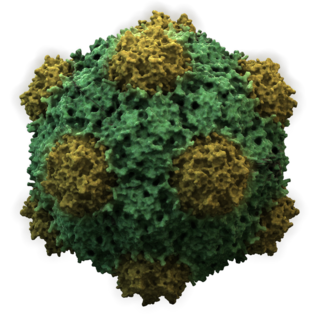A satellite is a subviral agent that depends on the coinfection of a host cell with a helper virus for its replication. Satellites can be divided into two major classes: satellite viruses and satellite nucleic acids. Satellite viruses, which are most commonly associated with plants, but are also found in mammals, arthropods, and bacteria, encode structural proteins to enclose their genetic material, which are therefore distinct from the structural proteins of their helper viruses. Satellite nucleic acids, in contrast, do not encode their own structural proteins, but instead are encapsulated by proteins encoded by their helper viruses. The genomes of satellites range upward from 359 nucleotides in length for satellite tobacco ringspot virus RNA (STobRV).

Bromoviridae is a family of viruses. Plants serve as natural hosts. There are currently 36 species in this family, divided among 6 genera.

Comovirinae is a subfamily of viruses in the order Picornavirales, in the family Secoviridae; its genera were formerly classified in the family Comoviridae. Plants serve as natural hosts. There are currently 62 species in this subfamily, divided among 3 genera.

Tobamovirus is a genus of positive-strand RNA viruses in the family Virgaviridae. Many plants, including tobacco, potato, tomato, and squash, serve as natural hosts. Diseases associated with this genus include: necrotic lesions on leaves. The name Tobamovirus comes from the host and symptoms of the first virus discovered.

Potyvirus is a genus of viruses in the family Potyviridae. Plants serve as natural hosts. There are currently 183 species in this genus including the type species Potato virus Y. The genus is named after the type virus. Potyviruses account for ~30% of the currently known plant viruses. Like begomoviruses, members of this genus may cause significant losses in agricultural, pastoral, horticultural and ornamental crops. More than 200 species of aphids spread potyviruses and most are from the subfamily Aphidinae.

Carmovirus is a genus of viruses, in the family Tombusviridae. Plants serve as natural hosts. There are currently 19 species in this genus including the type species Carnation mottle virus. It is classified under the Baltimore classification system as a group IV virus, having a single-stranded, positive-sense RNA genome.
Andean potato mottle virus (APMoV) is a plant pathogenic virus of the family Comoviridae.
Bidens mottle virus (BiMoV) is a pathogenic plant virus in the plant virus family Potyviridae. BiMoV is a flexuous filamentous particle, 720 nm long, and belongs to the Potyviridae genus Potyvirus. Like other viruses in this genus, Bidens mottle virus is transmitted both mechanically by sap and by aphids in a stylet-borne fashion.
Cassava green mottle virus (CGMV) is a plant pathogenic virus of the family Secoviridae.
Cereal chlorotic mottle virus (CCMoV) is a plant pathogenic virus of the family Rhabdoviridae.
Chilli veinal mottle virus (ChiVMV) is a plant pathogenic virus of the family Potyviridae.
Cocksfoot mottle virus (CfMV) is a pathogenic plant virus belonging to the genus Sobemovirus. The virus appears in southern and central England. It is transmitted by beetles Lema melanopa and Lema lichenis and is common in crops of cocksfoot and cocksfoot/legume mixtures.

Cowpea mild mottle virus (CPMMV) is a plant pathogenic virus of the family Betaflexiviridae that infects yardlong beans, soybeans and peanuts. It is transmitted by whiteflies that feed on the underside of plant leaves. Symptoms of infection include leaf malformation and mosaic, or spotted, patterns on the leaves. According to the Handbook of Plant Virus Diseases, the pathogen is found in "China, India, Indonesia, Ivory Coast, Nigeria, Thailand, Philippines, Papua New Guinea [and] Sudan".
Lettuce speckles mottle virus (LSMV) is a pathogenic plant virus.
Peanut mottle virus(PeMoV) is a plant pathogenic virus of the family Potyviridae. As with other members of this virus family, PeMoV is a flexuous filamentous virus with particles 740-750 nm long. It is transmitted by several species of aphids and by mechanical inoculation. It was first given its name in 1965 when it was isolated from peanuts in Georgia, USA. This virus was found to be seed transmitted in this host.
Primula mottle virus (PrMoV) is a plant pathogenic virus of the family Potyviridae.

Ilarvirus is a genus of positive-strand RNA viruses in the family Bromoviridae. Plants serve as natural hosts. There are currently 22 species in this genus including the type species Tobacco streak virus.
The genus Umbravirus includes plant viruses assigned to the family Tombusviridae. The genus has nine recognized species: Carrot mottle mimic virus, Carrot mottle virus, the type species, Ethiopian tobacco bushy top virus, Groundnut rosette virus, Lettuce speckles mottle virus, Opium poppy mosaic virus, Pea enation mosaic virus 2, Tobacco bushy top virus, and Tobacco mottle virus.

Aspiviridae, formerly Ophioviridae, is a family of segmented negative-strand RNA viruses which infect plants. Member viruses are characterized by an elongated and highly filamentous and flexible nucleocapsid with helical symmetry. It is a monotypic taxon containing only one genus, Ophiovirus. Aspiviridae is also the only family in the order Serpentovirales, which in turn is the only order in the class Milneviricetes.

Secoviridae is a family of viruses in the order Picornavirales. Plants serve as natural hosts. There are currently 86 species in this family, divided among 8 genera or not assigned to a genus. The family was created in 2009 with the grouping of families Sequiviridae, now dissolved, and Comoviridae, now subfamily Comovirinae, along with the then unassigned genera Cheravirus, Sadwavirus, and Torradovirus.







